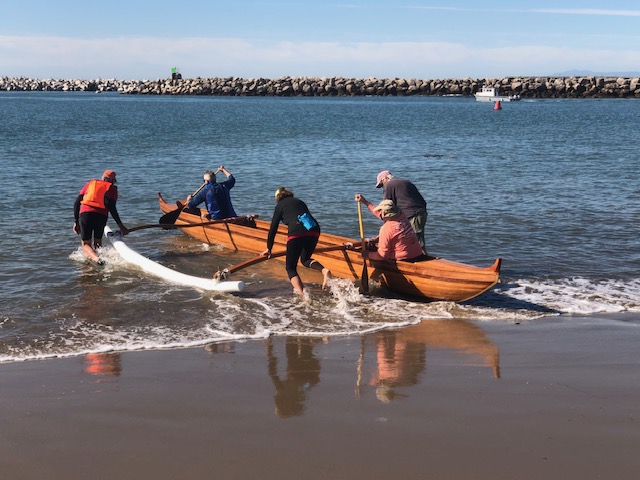Just prior to maiden voyage at Harbor Cove Beach.
Ventura resident Jon Huber is no stranger to Hawaiian outrigger canoes. The seventy-four-year-old is a senior member and past president of the Ventura Outrigger Canoe Club (VOCC). Paddling the club’s outrigger canoes several days a week has been a routine part of his schedule for years.
The club maintains various sizes of outriggers, but the mainstay of its fleet is the full-sized version known as the OC-6 (Outrigger Canoe – six person). The club’s OC-6 canoes are approximately 40 feet long and weigh 400+ pounds. The forebears of these contemporary fiberglass canoes were made of indigenous wood such as Hawaiian Koa and were the centerpiece of Polynesian culture. Huber long dreamed of building a wooden outrigger by hand, but the time was never right for the intensive, multi-month endeavor. That is, until the pandemic forced many people, including Huber, to stay at home.
Huber embarked on the project in May, 2020. In preparation, He studied existing outriggers, materials, and construction techniques. Ultimately, he originated his own unique design that combined the superior characteristics of existing canoes with his own knowledge of the specific ocean conditions that it would be intended for. Once started, the construction project took six months to complete. The result was a four-seat (OC-4) outrigger canoe made of a repertoire of wood for various parts of the canoe, including Western red cedar, Douglas fir, white oak and cherry.
The finished canoe measures 28 1/2 feet in length and weighs 100 pounds. While a group of VOCC members actively assisted in the construction, Huber did the lion’s share of the work. Simply put, it was Huber’s vision, craftsmanship, and perseverance that brought the project to a successful conclusion.
Once built, a major challenge was transporting the canoe from the backyard construction site to the beach without causing structural damage. The canoe was strapped atop a truck and gingerly “motorcaded” to the beach. Once transferred, the canoe underwent a series of tests to validate its seaworthiness. First, it was floated inside the harbor to test its watertight integrity, flotation balance, and freeboard. Then the canoe was taken out on the ocean for sea trials, during which its maneuvering characteristics were evaluated in various wind and swell conditions. Observation focused on the canoe’s geometry, specifically how it pitched, rolled, and yawed. As a final evaluation, the canoe was deliberately capsized. This was done to verify that when, not if, the canoe flipped over, it could be recovered quickly and safely.
Generally Hawaiian outriggers are given Hawaiian names. And so it is with Huber’s canoe, which he named “Keoni” meaning “John” in Hawaiian. New canoes are frequently dedicated with a formal blessing ceremony performed in time-honored Polynesian tradition. The club plans to have a shore-side blessing soon. In the meantime, Keoni has taken its rightful place among the club’s larger canoes as they ply the picturesque waters of Pierpont Bay.

